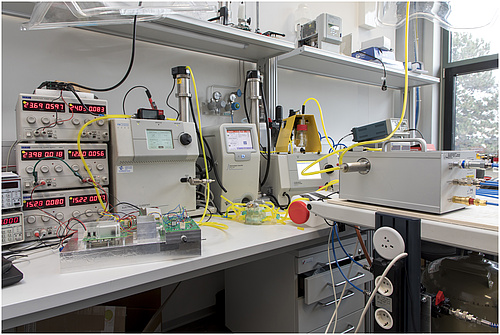Aerosol Reference Laboratory
One of the most pronounced research fields of IES is aerosol science with a focus towards sensing with respect to automotive applications as well as environmental sensing and the consumer market. In order to be at the forefront of aerosol science we operate an aerosol reference laboratory where we are able to generate, manipulate and classify a broad variety of aerosols. Tuneable characteristics of the particles cover size, shape, concertation, optical properties as well as chemical composition.
Aerosol Generators
We are able to generate aerosol particles of different materials including NaCl, soot, PSL, DEHS, WOx and silver with sizes between 5 nm and 5 um and concentrations up to 107 particles per cm3. For that purpose, our laboratory is equipped with different generators:
- TOPAS Aerosol Generator ATM220 and ATM221 (incl. Diffusion Dryer 570)
- Jing miniCast 6200
- GRIMM WOx-Tungsten-Generator Model 7.860
- Tube furnace
Aerosol Characterization
In order to get to a better understanding of the nature of aerosols and their interaction with the environment and sensors, we not only need to generate but also to characterize the particles.
The most important quantities to look at are particle size and number concentration, which are determined by the following devices:
- TSI SMPS 3938
The Scanning Mobility Particle Sizer from TSI is the working horse of every aerosol laboratory. It is able to classify particles in a range from five nanometres to one micrometre in diameter. Every kind of aerosol can be characterized by the SMPS, which is considered the gold standard of aerosol science.
- TSI CPC 3775
TSI’s Condensation Particle Counter 3775 counts particles starting from a diameter of only four nanometres. Particle concentrations from zero to 107 particles per cm3 can be determined with high accuracy.
- TSI APS 3321
For particles in a size range of 500 nm to 20 µm the Aerodynamic Particle Sizer from TSI is the measurement system to choose.
- Aerosol Electrometer
Aerosol electrometers represent the reference standard for the measurement of particle number concentration. Therefore, they are used e.g. to calibrate and validate condensation particle counters. Our own-built aerosol electrometer consists of a HEPA filter placed inside a shielded Faraday cup, which is connected to a Keithley 6517B Electrometer.

